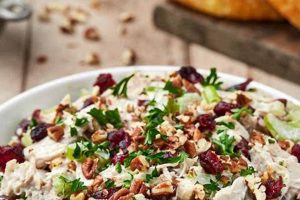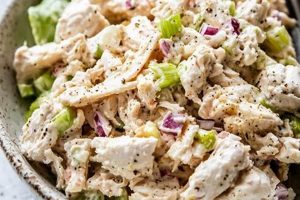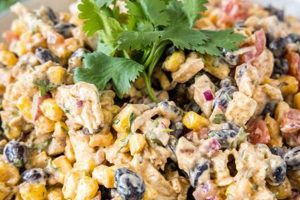This dish typically combines shredded chicken with mayonnaise, grapes, celery, and pecans, offering a sweet and savory flavor profile. Variations may include dried cranberries, apples, or other fruits and nuts. It is often served on fresh bread as a sandwich or enjoyed as a salad.
The blend of protein-rich chicken, healthy fats, and the refreshing crunch of fruits and vegetables makes this type of salad a nutritious and satisfying meal option. Its popularity has led to numerous adaptations and copycat recipes, demonstrating its enduring appeal as a quick and flavorful dish suitable for various occasions, from casual lunches to picnics and potlucks. The dish often reflects a desire for homemade comfort food, highlighting the importance of fresh ingredients and balanced flavors.
Further exploration of this culinary creation can involve discussions on ingredient sourcing, variations on the classic preparation, nutritional information, and tips for achieving the perfect balance of textures and tastes. Understanding the foundational elements of the dish opens doors to experimentation and personalized interpretations.
Tips for an Exceptional Chicken Salad
Achieving a well-balanced and flavorful chicken salad requires attention to detail and an understanding of the interplay between ingredients. The following tips offer guidance for elevating this classic dish.
Tip 1: Poaching for Tender Chicken: Poaching chicken breasts results in tender, flavorful meat ideal for salad. Simmering the chicken in seasoned broth ensures optimal moisture and allows for greater control over the final taste.
Tip 2: Freshly Chopped Ingredients: Pre-cut ingredients can compromise flavor and texture. Chopping celery, grapes, and other components just before mixing enhances the overall freshness and crispness of the salad.
Tip 3: The Mayonnaise Matters: High-quality mayonnaise significantly impacts the final product. Experimenting with different brands or making mayonnaise from scratch can add depth and richness.
Tip 4: Balancing Sweet and Savory: A delicate balance of sweet and savory elements is essential. The sweetness of grapes or dried cranberries should complement, not overpower, the savory chicken and mayonnaise.
Tip 5: Seasoning Strategically: Seasoning beyond salt and pepper can elevate the flavor profile. Consider incorporating herbs like dill or tarragon, or spices like paprika or celery seed.
Tip 6: Chill Before Serving: Chilling the salad allows the flavors to meld and enhances the overall experience. A minimum of 30 minutes of refrigeration is recommended.
Tip 7: Creative Bread Choices: While classic sandwich bread is always an option, exploring different bread varieties, such as croissants, rolls, or crackers, can add interesting textural and flavor dimensions.
By focusing on quality ingredients, thoughtful preparation, and strategic flavor combinations, one can transform a simple chicken salad into a culinary masterpiece.
These tips provide a framework for crafting exceptional chicken salad. Adaptation and experimentation are encouraged to achieve personalized flavor profiles.
1. High-quality Chicken
High-quality chicken serves as the cornerstone of a successful rendition. The chicken’s flavor and texture significantly impact the final result. Chicken that is dry, stringy, or bland can detract from the overall experience, while moist, tender, and flavorful chicken elevates the dish. The choice of chicken directly influences the perceived quality and enjoyment. For instance, using freshly roasted or poached chicken, as opposed to pre-cooked or processed options, typically yields a superior outcome due to better moisture retention and flavor development. This foundational ingredient sets the stage for the other components to shine.
The impact of using high-quality chicken extends beyond the immediate taste. It contributes to a more satisfying and enjoyable culinary experience. The texture of the chicken interacts with the other ingredients, creating a harmonious blend. Tender chicken absorbs the flavors of the dressing and complements the crunch of celery and nuts. Conversely, inferior chicken can create an unpleasant, unbalanced texture and muted flavor profile. Consider the difference between using freshly poached chicken breast versus using canned chicken. The fresh chicken offers a cleaner flavor and a more appealing texture, contributing to a more refined final product. Investing in quality chicken directly translates to a more rewarding sensory experience.
Prioritizing high-quality chicken demonstrates a commitment to excellence. It signifies an understanding of the crucial role this ingredient plays in the overall success of the dish. Selecting premium chicken ensures a delectable and memorable experience for anyone enjoying this classic. While cost considerations may tempt some to opt for less expensive options, the noticeable difference in the final result justifies the investment in superior quality chicken. This focus on quality underscores the importance of respecting the integrity of each ingredient and its contribution to the culinary experience.
2. Fresh Ingredients
Fresh ingredients are fundamental to a high-quality chicken salad experience, directly impacting the overall flavor, texture, and enjoyment. The emphasis on freshness elevates this simple dish, transforming it from ordinary to exceptional. Utilizing fresh components allows the inherent flavors of each ingredient to shine through, creating a vibrant and nuanced flavor profile.
- Crispness and Texture
Fresh produce provides a satisfying textural contrast to the creamy mayonnaise and tender chicken. Crisp celery, for example, adds a refreshing crunch, while the firm texture of grapes offers a pleasing burst of sweetness. Wilted or mushy produce detracts from this essential textural element. Imagine the difference between a salad with crisp, freshly chopped celery versus one using celery that has been pre-cut and stored for several days. The fresh celery contributes a vibrant crunch, while the older celery might be limp and less flavorful.
- Enhanced Flavor Profile
Freshly chopped herbs, such as chives or parsley, and vibrant vegetables contribute bright, nuanced flavors that pre-packaged or older ingredients often lack. These fresh components add depth and complexity to the salad, enhancing the overall sensory experience. Consider the distinction between freshly squeezed lemon juice and bottled lemon juice. The fresh juice offers a brighter, more pronounced citrus flavor, while the bottled version may taste duller or more artificial.
- Visual Appeal
Vibrant, fresh ingredients contribute to an aesthetically pleasing presentation. The bright colors of fresh herbs, vegetables, and fruits create a visually appealing dish that is more appetizing. A salad made with fresh, vibrant ingredients is naturally more attractive than one made with dull, older ingredients. The visual appeal enhances the overall dining experience.
- Preservation of Nutrients
Fresh ingredients retain more of their natural vitamins and nutrients compared to processed or older counterparts. This nutritional value adds to the health benefits of the salad. Freshly chopped produce retains its vitamin C content, while pre-cut produce can lose a significant portion of this nutrient due to oxidation. This focus on freshness contributes to a healthier and more nutritious meal.
The commitment to fresh ingredients elevates chicken salad from a simple dish to a culinary experience. The interplay of fresh flavors, crisp textures, and vibrant colors contributes to a more satisfying and enjoyable meal. By prioritizing freshness, one ensures that the final product is both flavorful and nutritious, demonstrating a commitment to quality and culinary excellence. This emphasis on fresh components ultimately distinguishes an exceptional chicken salad from a mediocre one.
3. Balanced Sweetness
Balanced sweetness plays a crucial role in defining the character of this dish. The sweetness level significantly influences the overall flavor profile and enjoyment. A precise calibration of sweetness prevents the salad from becoming overly sweet or bland, allowing the other flavors to shine through. Understanding the nuances of achieving this balance is essential for replicating the signature taste. The interplay between sweet and savory elements distinguishes this dish from other chicken salads, highlighting the importance of careful ingredient selection and proportioning.
- Sweet Ingredient Choice
The choice of sweet ingredients significantly influences the flavor profile and overall balance. Common options include grapes, dried cranberries, or chopped apples. Each option offers a unique sweetness level and textural contribution. For example, grapes provide a juicy sweetness and a pleasant pop, while dried cranberries offer a more concentrated sweetness and a chewier texture. The selection of the sweet component should complement the other ingredients and contribute to a harmonious flavor profile.
- Proportion and Balance
The proportion of sweet ingredients to other components directly impacts the balance of the salad. Too much sweetness can overpower the savory notes of the chicken and mayonnaise, while too little can result in a bland, uninspired dish. Careful measurement and adjustment are essential to achieving the desired balance. For instance, if using grapes, consider the size and sweetness of the grapes themselves. Adjusting the quantity based on these factors helps maintain a balanced sweetness profile.
- Interaction with Savory Elements
The sweetness interacts directly with the savory elements of the salad, creating a complex and balanced flavor profile. The savory notes of the chicken, mayonnaise, and any added seasonings counterbalance the sweetness, preventing it from becoming overwhelming. This interplay is crucial for a well-rounded and enjoyable experience. Consider adding a pinch of salt to enhance the savory notes and create a more dynamic contrast with the sweet ingredients.
- Impact on Overall Perception
The level of sweetness directly influences the overall perception of the dish. A well-balanced sweetness enhances the other flavors, creating a harmonious and satisfying experience. An imbalance, however, can detract from the other ingredients and leave a less favorable impression. A properly balanced sweetness allows the individual flavors of the chicken, celery, nuts, and mayonnaise to shine through while contributing to the overall complexity and enjoyment of the dish.
Achieving balanced sweetness is essential for a successful rendition of this classic dish. The careful selection, proportioning, and interplay of sweet and savory components contribute significantly to the overall flavor profile and enjoyment. This delicate balance distinguishes this dish from other chicken salads and exemplifies the importance of thoughtful ingredient selection and preparation. The ultimate goal is a harmonious blend of flavors where the sweetness enhances, rather than dominates, the overall culinary experience.
4. Textural Contrast
Textural contrast is a defining characteristic of a well-executed chicken salad, contributing significantly to its appeal and enjoyment. The interplay of different textures creates a dynamic sensory experience, elevating the dish beyond a simple combination of ingredients. This contrast prevents monotony and adds complexity, making each bite more engaging and satisfying. Understanding the role of textural variation is crucial for replicating the desired outcome.
- Chicken Tenderness
The tenderness of the chicken provides a foundational textural element. Shredded or diced chicken offers a soft, yielding texture that contrasts with other components. Overcooked, dry chicken disrupts this balance, resulting in a less enjoyable experience. Properly cooked chicken absorbs the flavors of the dressing and interacts harmoniously with the other textural elements. For example, poached or rotisserie chicken offers optimal tenderness.
- Crisp Vegetables
Crisp vegetables, such as celery, offer a refreshing crunch that contrasts with the softer textures of the chicken and mayonnaise. This crispness adds a dynamic element, preventing the salad from becoming overly smooth or mushy. The structural integrity of the vegetables is crucial for maintaining this textural contrast. Water chestnuts or chopped bell peppers could also provide textural variation.
- Nut Integration
Nuts, typically pecans or walnuts, introduce a satisfying crunch and a subtle earthy flavor. The nuts’ size and texture contribute significantly to the overall textural profile. Toasted nuts offer an intensified flavor and enhanced crispness. Slivered almonds or chopped cashews can also be incorporated for textural and flavor variations.
- Fruit Incorporation (Optional)
The addition of fruits, such as grapes or dried cranberries, introduces another layer of textural complexity. Grapes offer a juicy burst, while dried cranberries provide a chewy texture. The choice of fruit and its preparation influence the overall textural balance. Diced apples or chopped apricots could also offer unique textural and flavor dimensions.
The interplay of these textural elements creates a multi-dimensional culinary experience. The combination of tender chicken, crisp vegetables, crunchy nuts, and potentially chewy or juicy fruits elevates the salad from simple to sophisticated. A successful chicken salad hinges on the careful balance and integration of these various textures, resulting in a dish that is both flavorful and texturally stimulating. Each bite offers a complex interplay of sensations, contributing to a more engaging and satisfying meal.
5. Proper Seasoning
Proper seasoning is essential for a well-balanced and flavorful chicken salad. Seasoning elevates the inherent flavors of the ingredients, creating a more complex and satisfying profile. It transforms a bland mixture into a vibrant, well-rounded dish. The interplay of seasonings with other components, such as mayonnaise, fruits, and vegetables, is crucial for achieving the desired taste. The absence of proper seasoning can result in a flat, uninspired salad, while judicious use of seasonings enhances the overall culinary experience. For instance, a simple addition of salt and freshly cracked black pepper can significantly improve the taste, while incorporating herbs like dill or tarragon can add depth and complexity.
Different seasonings contribute unique characteristics to the final product. Salt enhances the savory notes of the chicken and other ingredients, while pepper adds a subtle bite. Herbs, spices, and other seasonings introduce nuanced flavors that complement the core ingredients. The choice of seasonings should be tailored to individual preferences and the overall flavor profile desired. Experimentation with various seasoning combinations can lead to unique and personalized versions of the classic recipe. The impact of each seasoning choice should be carefully considered to ensure a harmonious balance of flavors. For example, a combination of paprika and celery seed might complement a sweeter salad with grapes, while dill and lemon zest could enhance a salad with a brighter, more citrus-forward profile. Over-seasoning can overwhelm the delicate flavors of the chicken and other ingredients, while under-seasoning can result in a bland and unappetizing dish. The goal is to achieve a harmonious blend where each seasoning enhances the overall flavor profile without dominating it.
Mastering the art of proper seasoning requires attention to detail and a nuanced understanding of flavor interactions. It involves considering the individual characteristics of each seasoning and how it contributes to the final product. The careful selection and application of seasonings are essential for achieving a well-balanced and flavorful chicken salad. This attention to detail elevates the dish from simple to exceptional, showcasing the transformative power of proper seasoning. Ultimately, a properly seasoned chicken salad demonstrates a commitment to culinary excellence, resulting in a more satisfying and enjoyable dining experience.
6. Mayonnaise Choice
Mayonnaise serves as the unifying element in chicken salad, binding the ingredients and contributing significantly to the overall flavor and texture. The choice of mayonnaise is therefore a crucial factor in replicating the distinct characteristics often associated with versions like Kneaders’ chicken salad. Selecting the right mayonnaise requires careful consideration of various factors, including flavor profile, consistency, and quality. The interplay between the mayonnaise and other ingredients determines the final character of the salad.
- Flavor Profile
Mayonnaise varieties exhibit diverse flavor profiles, ranging from tangy to sweet, and from classic to infused with herbs or spices. This inherent flavor directly impacts the overall taste of the chicken salad. For instance, a mayonnaise with a pronounced tang can balance the sweetness of added fruits, while a more neutral mayonnaise allows the flavors of the chicken and other ingredients to take center stage. The flavor profile of the mayonnaise should complement, not overpower, the other components.
- Consistency and Texture
Mayonnaise consistency ranges from thick and creamy to light and airy. This texture influences the overall mouthfeel of the salad and how well it binds the ingredients. A thicker mayonnaise creates a richer, denser salad, while a thinner mayonnaise results in a lighter, looser texture. The desired consistency depends on personal preference and the specific recipe. For example, a thicker mayonnaise might be preferred for a classic chicken salad sandwich, while a lighter mayonnaise might be suitable for a chicken salad served over greens.
- Quality of Ingredients
The quality of ingredients used in the mayonnaise impacts both flavor and texture. High-quality mayonnaise typically contains fewer additives and preservatives, resulting in a cleaner flavor profile. The type of oil used in the mayonnaise also influences the taste and texture. For instance, mayonnaise made with olive oil offers a distinct flavor compared to mayonnaise made with soybean oil. Using high-quality mayonnaise contributes to a more refined and flavorful salad.
- Interaction with Other Ingredients
The mayonnaise interacts directly with the other ingredients in the salad, influencing the overall flavor and texture. The acidity of the mayonnaise balances the richness of the chicken and other ingredients, while the fat content contributes to the creamy texture. The interplay between the mayonnaise and other components is crucial for achieving the desired balance. For example, a sweeter mayonnaise might pair well with tart apples and pecans, while a tangier mayonnaise could complement grapes and celery.
The choice of mayonnaise is a defining factor in the overall quality and character of chicken salad. Careful consideration of flavor profile, consistency, quality, and interaction with other ingredients is essential for achieving the desired outcome. Selecting the appropriate mayonnaise contributes significantly to replicating variations similar to Kneaders, ultimately elevating the dish from simple to exceptional.
7. Serving Method
The serving method contributes significantly to the overall enjoyment and perceived quality of a chicken salad experience, particularly when aiming to emulate the style of a popular establishment like Kneaders. While the core recipe provides the foundation, the presentation and method of service enhance the dining experience. Different serving methods influence the perception of the salad, impacting convenience, visual appeal, and overall satisfaction. Consideration of these factors ensures the chosen method complements the carefully crafted flavors and textures of the salad itself.
- Classic Sandwich
Serving the chicken salad as a sandwich on freshly baked bread is a timeless and popular choice. The bread’s texture and flavor complement the salad, creating a satisfying and convenient meal. Kneaders, known for its bread, often utilizes its freshly baked varieties for chicken salad sandwiches. The bread choice significantly impacts the overall experience, influencing both flavor and texture. Options range from classic white or wheat bread to specialty breads like croissants or sourdough. The sandwich format provides portability and ease of consumption, making it ideal for lunches, picnics, or quick meals.
- Elegant Salad Plate
Presenting the chicken salad as a stand-alone salad on a plate elevates the dish, offering a more formal and visually appealing presentation. This approach allows the textures and colors of the salad to shine. Garnishing with fresh herbs or a sprinkle of paprika enhances the presentation further. This serving method is suitable for luncheons, catered events, or a lighter meal option. Accompaniments like crackers, a small green salad, or fruit slices can complement the chicken salad and create a balanced plate.
- Versatile Wraps or Scoops
Using wraps, such as tortillas or lettuce cups, offers a lighter and more contemporary alternative to traditional bread. This method provides flexibility in portion size and allows for creative ingredient combinations. Adding elements like shredded lettuce, diced tomatoes, or a drizzle of vinaigrette enhances both flavor and visual appeal. This serving method is particularly suitable for casual gatherings or those seeking a lower-carbohydrate option. The choice of wrap influences the overall flavor profile, with options ranging from whole wheat tortillas to spinach wraps or crisp lettuce cups.
- Creative Catering Options
For larger gatherings or catered events, chicken salad can be presented in various creative formats. Mini croissants, tartlets, or endive spears offer elegant and bite-sized portions. Serving the chicken salad in a hollowed-out tomato or avocado adds visual interest and enhances the presentation. These creative options elevate the perceived value of the dish and create a memorable catering experience. Such presentations showcase the versatility of chicken salad and its adaptability to different serving formats.
The chosen serving method significantly influences the overall perception and enjoyment of chicken salad. Whether presented as a classic sandwich, an elegant salad plate, a versatile wrap, or a creative catering option, the serving method should complement the carefully crafted flavors and textures of the salad. Drawing inspiration from establishments like Kneaders, known for their varied and appealing presentation styles, highlights the importance of considering the serving method as an integral part of the culinary experience. The method of service enhances the visual appeal, convenience, and overall satisfaction, transforming a simple chicken salad into a memorable meal.
Frequently Asked Questions
This section addresses common inquiries regarding recreating dishes similar to Kneaders’ chicken salad, offering clarity and guidance for optimal results.
Question 1: What type of chicken is best suited for this style of salad?
Rotisserie chicken offers a convenient shortcut, while poaching or grilling boneless, skinless chicken breasts allows for greater control over seasoning and texture. Canned chicken is generally less desirable due to its texture and potential for added sodium.
Question 2: How can sweetness be balanced effectively?
Balancing sweetness involves careful consideration of the chosen sweet ingredients, whether grapes, dried cranberries, or apples. The quantity should complement, not overpower, the savory elements. A pinch of salt can enhance savory notes and create a more balanced flavor profile.
Question 3: What mayonnaise is recommended?
High-quality mayonnaise is crucial. Consider flavor profiles, ranging from tangy to sweet. The consistency should align with the desired texture of the salad, whether creamy or lighter. Experimentation with different brands or homemade mayonnaise is encouraged.
Question 4: What contributes most significantly to the salad’s textural complexity?
The interplay of tender chicken, crisp vegetables (like celery), and crunchy nuts (like pecans or walnuts) creates the signature textural contrast. Freshly chopped ingredients are essential for optimal crispness and flavor. Consider adding fruits like grapes or dried cranberries for additional textural variation.
Question 5: How long can chicken salad be stored safely?
Properly stored in an airtight container in the refrigerator, chicken salad typically lasts for 3-5 days. Indicators of spoilage include a sour odor, discoloration, or a slimy texture. Adhering to food safety guidelines is paramount for preventing foodborne illnesses.
Question 6: Can the recipe be adapted for specific dietary needs?
The recipe can be adapted for various dietary preferences. Using Greek yogurt instead of mayonnaise reduces fat and calories. Gluten-free bread or lettuce wraps cater to gluten-free diets. Adjustments to ingredients and seasonings can accommodate other dietary restrictions or preferences, such as omitting nuts for allergies or reducing sodium for health concerns.
By understanding these core elements and addressing common concerns, one can confidently embark on recreating this popular dish. Careful attention to detail and ingredient selection ensures a successful and satisfying culinary experience.
Exploration of specific recipe variations and further culinary insights can provide a deeper understanding and appreciation for this classic dish.
Kneaders Chicken Salad Recipe
This exploration of the elements that contribute to a successful Kneaders-style chicken salad recipe has highlighted the importance of ingredient quality, balanced flavors, and textural contrasts. From the selection of premium chicken to the careful proportioning of sweet and savory components, each element plays a crucial role in the final product. The analysis of proper seasoning, mayonnaise choice, and serving methods further emphasizes the attention to detail required for achieving a truly exceptional chicken salad. Understanding these core principles empowers culinary enthusiasts to recreate and personalize this classic dish.
The enduring appeal of chicken salad lies in its adaptability and potential for culinary creativity. By embracing the foundational principles discussed herein, individuals can elevate this seemingly simple dish to new heights. Continued experimentation with ingredients, seasonings, and presentation styles promises further culinary discoveries and a deeper appreciation for the nuanced artistry of chicken salad.






